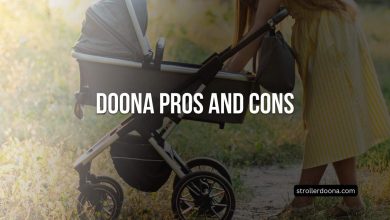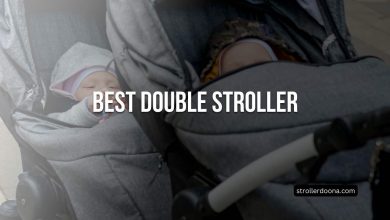What stroller to buy
Becoming a parent comes with a multitude of decisions, and choosing the right stroller is undoubtedly one of the most important. A stroller isn’t just a means of transporting your child; it’s a vital tool that can make your daily life easier or more challenging, depending on your choice. With the myriad of options available in the market, from lightweight travel systems to rugged all-terrain models, finding the perfect fit for your family can seem overwhelming.
This guide aims to simplify your decision-making process by providing a comprehensive overview of everything you need to know about selecting a stroller. We’ll explore various types of strollers, essential features to consider, safety aspects, and how to align your choice with your lifestyle and budget. Whether you’re expecting your first child or looking to upgrade your current stroller, this article will equip you with the knowledge to make an informed decision that best suits your family’s needs.
Understanding Different Types of Strollers
Before diving into specific features and considerations, it’s crucial to understand the main types of strollers available. Each type serves different purposes and lifestyles, so familiarizing yourself with these options is the first step in narrowing down your choices.
1. Full-Size Strollers
Full-size strollers are the workhorses of the stroller world. They offer the most features and tend to be the most durable option.
Pros:
- Sturdy and durable
- Ample storage space
- Fully-reclining seats
- Adjustable handlebars
- Robust wheels for various terrains
Cons:
- Heavier and bulkier
- Can be challenging to transport or store
- Often more expensive
Best for: Families who prioritize comfort and features over portability, those who take frequent, long walks, or parents who want a stroller that can grow with their child.
2. Lightweight or Umbrella Strollers
These strollers are designed for ease of use and portability, making them perfect for travel or quick errands.
Pros:
- Extremely lightweight and compact
- Easy to fold and carry
- Ideal for travel
- Usually more affordable
Cons:
- Limited features and storage
- May not be suitable for newborns
- Less durable than full-size options
Best for: Parents who are always on-the-go, frequent travelers, or those looking for a secondary stroller for quick trips.
3. Jogging Strollers
Designed for parents who want to stay active, jogging strollers feature three large wheels and enhanced suspension systems.
Pros:
- Excellent maneuverability
- Smooth ride on various terrains
- Sturdy construction
- Often comes with hand brakes
Cons:
- Bulkier and heavier than standard strollers
- Can be expensive
- May not be suitable for everyday use in tight spaces
Best for: Active parents who enjoy running or walking on diverse terrains, or those living in areas with uneven sidewalks or trails.
4. Travel Systems
Travel systems include a stroller and a compatible infant car seat, offering a seamless transition from car to stroller.
Pros:
- Convenient for transitioning sleeping infants
- Cost-effective as a package deal
- Car seat can be used separately as the child grows
Cons:
- Can be bulky and heavy
- The included stroller may not be the best quality
- Limited long-term use as the child outgrows the infant car seat
Best for: New parents looking for an all-in-one solution, especially for the newborn stage.
5. Double Strollers
Designed for parents with twins or children close in age, double strollers come in side-by-side or tandem (front and back) configurations.
Pros:
- Allows for transporting two children simultaneously
- Often features individual reclining seats and canopies
- Some models convert from single to double
Cons:
- Wider and heavier than single strollers
- Can be challenging to maneuver in tight spaces
- Often more expensive
Best for: Parents with twins, two young children, or those planning on having children close together.
Essential Features to Consider
Now that we’ve covered the main types of strollers, let’s delve into the key features that can make a significant difference in your day-to-day use of the stroller.
1. Safety Features
Safety should be your top priority when choosing a stroller. Look for the following features:
- Five-point harness: Ensures your child is securely fastened.
- Brakes: Easy-to-use brakes are essential for keeping the stroller stationary.
- Canopy: Protects your child from sun, wind, and light rain.
- Sturdy frame: Ensures stability and durability.
- JPMA certification: Indicates compliance with safety standards set by the Juvenile Products Manufacturers Association.
2. Maneuverability
The ease of pushing and steering your stroller can greatly impact your daily experiences. Consider:
- Wheel size and type: Larger wheels generally offer a smoother ride and better maneuverability.
- Swivel vs. fixed front wheels: Swivel wheels are great for tight spaces, while fixed wheels provide stability for jogging.
- Suspension system: Helps absorb shocks for a smoother ride, especially important for newborns.
3. Comfort Features
Both your child’s comfort and your own are important factors. Look for:
- Adjustable handlebar: Ensures comfortable pushing for parents of different heights.
- Reclining seat: Allows for comfortable napping and diaper changes.
- Leg rest: Provides support for your child’s legs, especially important for infants.
- Padding: Ensures a comfortable ride for your child.
4. Storage and Accessories
Adequate storage can make outings much more convenient. Consider:
- Storage basket: Look for a large, easily accessible basket for diaper bags and other essentials.
- Cup holders: For both parent and child.
- Snack tray: Useful for older babies and toddlers.
- Parent organizer: Keeps essentials like phones and keys within easy reach.
5. Portability
If you’ll be frequently lifting or transporting your stroller, consider:
- Weight: Lighter strollers are easier to lift and carry.
- Folding mechanism: One-handed fold options can be incredibly convenient.
- Compact fold: Important if you have limited storage space or a small car trunk.
6. Versatility and Longevity
To maximize your investment, look for strollers that can adapt as your child grows:
- Reversible seat: Allows your child to face you or face forward.
- Adjustable footrest: Accommodates your growing child.
- Car seat compatibility: Allows for use with an infant car seat.
- Convertible options: Some strollers can convert from single to double, or add a standing platform for an older child.
Aligning Your Choice with Your Lifestyle
Your lifestyle plays a crucial role in determining the best stroller for your family. Consider the following scenarios:
Urban Living
If you live in a city, prioritize:
- Compact, lightweight designs for navigating crowded sidewalks and public transportation
- Excellent maneuverability for tight spaces
- Durable wheels for handling curbs and uneven pavement
Recommended types: Lightweight strollers or compact full-size strollers with good maneuverability
Suburban or Rural Areas
For those in less densely populated areas, consider:
- All-terrain capabilities for various surfaces (grass, gravel, etc.)
- Larger wheels for a smoother ride
- Ample storage for longer outings
Recommended types: Jogging strollers or full-size strollers with robust wheels
Frequent Travelers
If you travel often, look for:
- Lightweight, compact designs
- Easy, one-handed folding mechanisms
- Travel system compatibility for seamless car-to-stroller transitions
Recommended types: Lightweight or umbrella strollers, travel systems
Active Lifestyles
For parents who enjoy outdoor activities or exercise, prioritize:
- Jogging or all-terrain capabilities
- Adjustable handlebars for comfort while running
- Larger wheels and good suspension for a smooth ride
Recommended types: Jogging strollers or all-terrain strollers
Budget Considerations
Strollers can range from under $100 to over $1000, so it’s important to set a realistic budget. Consider the following:
Entry-Level ($100-$300)
- Basic features and functionality
- Suitable for occasional use or as a secondary stroller
- May lack durability for heavy, long-term use
Mid-Range ($300-$700)
- Good balance of features and quality
- Suitable for everyday use
- Often includes additional accessories
High-End ($700+)
- Premium materials and construction
- Advanced features and customization options
- Often convertible or adaptable for long-term use
Tip: Consider long-term value. A more expensive stroller that lasts through multiple children or converts as your family grows may be more cost-effective than replacing cheaper models repeatedly.
Stroller Safety and Maintenance
Ensuring your child’s safety goes beyond choosing a stroller with the right features. Proper use and maintenance are equally important.
Safety Tips:
- Always use the safety harness, even for short trips.
- Engage the brakes when the stroller is stationary.
- Don’t hang heavy bags on the handlebars, which can cause tipping.
- Keep your child’s fingers away from hinges when folding or unfolding.
- Check the stroller regularly for any loose parts or wear and tear.
Maintenance:
- Clean the fabric regularly according to manufacturer instructions.
- Lubricate wheels and moving parts as needed.
- Check and tighten screws periodically.
- Store in a dry place to prevent rusting or mold growth.
Making Your Decision: A Step-by-Step Approach
- Assess your lifestyle: Consider where you live, how you’ll use the stroller, and your family’s needs.
- Set a budget: Determine how much you’re willing to spend, keeping in mind long-term value.
- Prioritize features: Based on your lifestyle, decide which features are must-haves and which are nice-to-haves.
- Research and compare: Look at reviews from other parents and compare different models within your chosen category.
- Test drive: Visit stores to try out different strollers. Pay attention to how easy they are to push, fold, and maneuver.
- Consider growth: Think about how long you plan to use the stroller and whether you might have more children in the future.
- Check for recalls: Before making a final decision, check if the model you’re considering has any safety recalls.
Frequently Asked Questions
Q1: When should I start shopping for a stroller?
A: It’s best to start researching and shopping for a stroller in your second trimester. This gives you enough time to compare options, test models, and make an informed decision before your baby arrives.
Q2: Can I use a regular stroller for jogging?
A: It’s not recommended. Jogging strollers are specifically designed with features like enhanced suspension, hand brakes, and fixed front wheels to ensure your child’s safety at higher speeds and on uneven terrain.
Q3: Are expensive strollers worth the investment?
A: Higher-priced strollers often offer better quality materials, more features, and longer usability. However, many mid-range strollers provide excellent value. The “worth” depends on your specific needs and how you plan to use the stroller.
Q4: How long can I use a stroller?
A: Most strollers are designed to be used from birth (or 3-6 months for some models) up to about 3-4 years of age, or until your child reaches the stroller’s weight limit (typically around 50-55 pounds).
Q5: Do I need more than one stroller?
A: Many families find it useful to have two strollers: a full-featured one for everyday use and a lightweight one for travel or quick trips. However, some versatile strollers can fulfill both roles.
Conclusion
Choosing the right stroller is a significant decision that can greatly impact your daily life as a parent. By understanding the different types of strollers available, considering essential features, and aligning your choice with your lifestyle and budget, you can find a stroller that meets your family’s needs perfectly.
Remember, there’s no one-size-fits-all solution when it comes to strollers. What works best for one family may not be ideal for another. Take your time to research, test different models, and consider your specific requirements before making a decision.
Ultimately, the best stroller is one that provides safety and comfort for your child while making your life as a parent easier and more enjoyable. With the information provided in this guide, you’re now well-equipped to navigate the world of strollers and find the perfect match for your family’s adventures.
Happy stroller shopping, and enjoy the countless memories you’ll make with your little one on your journeys together!

